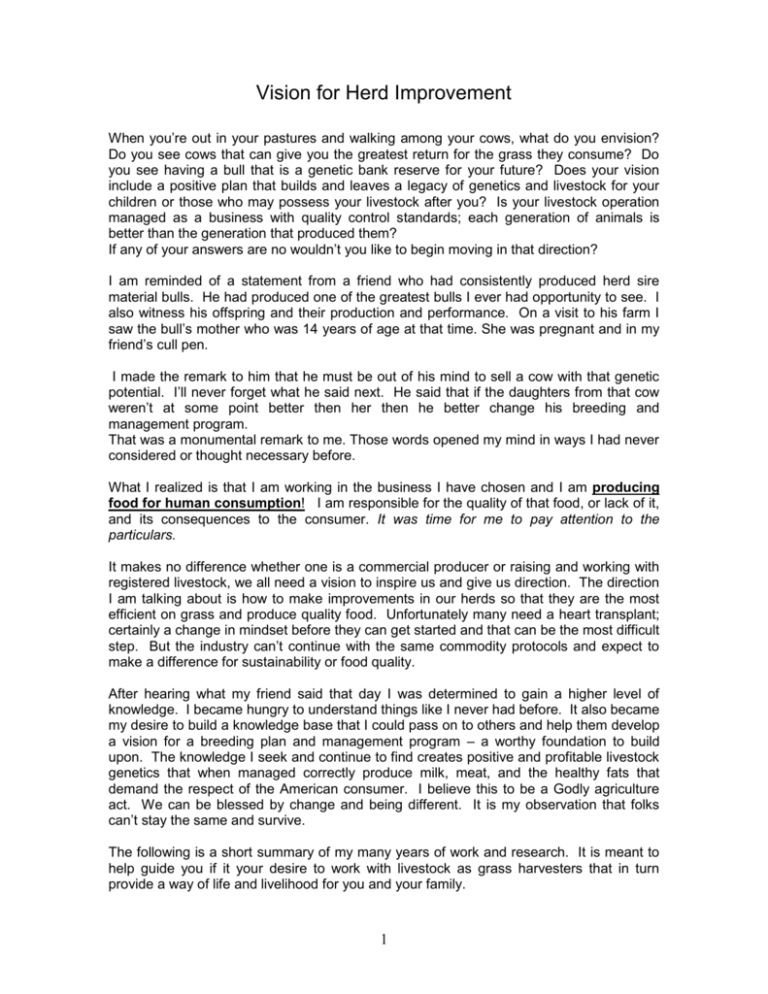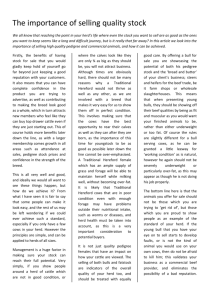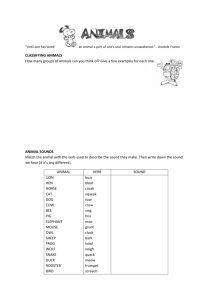Vision for a Herd Improvement Program
advertisement

Vision for Herd Improvement When you’re out in your pastures and walking among your cows, what do you envision? Do you see cows that can give you the greatest return for the grass they consume? Do you see having a bull that is a genetic bank reserve for your future? Does your vision include a positive plan that builds and leaves a legacy of genetics and livestock for your children or those who may possess your livestock after you? Is your livestock operation managed as a business with quality control standards; each generation of animals is better than the generation that produced them? If any of your answers are no wouldn’t you like to begin moving in that direction? I am reminded of a statement from a friend who had consistently produced herd sire material bulls. He had produced one of the greatest bulls I ever had opportunity to see. I also witness his offspring and their production and performance. On a visit to his farm I saw the bull’s mother who was 14 years of age at that time. She was pregnant and in my friend’s cull pen. I made the remark to him that he must be out of his mind to sell a cow with that genetic potential. I’ll never forget what he said next. He said that if the daughters from that cow weren’t at some point better then her then he better change his breeding and management program. That was a monumental remark to me. Those words opened my mind in ways I had never considered or thought necessary before. What I realized is that I am working in the business I have chosen and I am producing food for human consumption! I am responsible for the quality of that food, or lack of it, and its consequences to the consumer. It was time for me to pay attention to the particulars. It makes no difference whether one is a commercial producer or raising and working with registered livestock, we all need a vision to inspire us and give us direction. The direction I am talking about is how to make improvements in our herds so that they are the most efficient on grass and produce quality food. Unfortunately many need a heart transplant; certainly a change in mindset before they can get started and that can be the most difficult step. But the industry can’t continue with the same commodity protocols and expect to make a difference for sustainability or food quality. After hearing what my friend said that day I was determined to gain a higher level of knowledge. I became hungry to understand things like I never had before. It also became my desire to build a knowledge base that I could pass on to others and help them develop a vision for a breeding plan and management program – a worthy foundation to build upon. The knowledge I seek and continue to find creates positive and profitable livestock genetics that when managed correctly produce milk, meat, and the healthy fats that demand the respect of the American consumer. I believe this to be a Godly agriculture act. We can be blessed by change and being different. It is my observation that folks can’t stay the same and survive. The following is a short summary of my many years of work and research. It is meant to help guide you if it your desire to work with livestock as grass harvesters that in turn provide a way of life and livelihood for you and your family. 1 Always remember we are in the business of producing fine food and we must do that responsibly. Training your children is the second most important responsibility of this endeavor; however you must be trained first. I was introduced to Tom Lasiter in 1956, Dr Jan Bonsma in 1978, Buck Chastain in 1988, Harlan Doeschot in 1995. I got to know Teddy Gentry beginning in 1999, Ken McDowall in 2003, and Billy Don Finnon in 2006. These and many other successful stockmen have provided priceless information about livestock management, selection and breeding. These practices are still as valid today as when I met each man. Each of these men has left a deep-seated artisan desire in my heart and spirit to practice truth and reality in my cattle operation and to teach this truth and reality to other cattle producers. All of these men were students of truths and reality before they became teachers and mentors. Each had concerns about the quality of product they produced for human food. What is most intriguing is how each cattleman used animal selection, breeding and management practices that were unique and relative to their own environments yet in reality turned out to be quite similar. I continued consulting with hundreds of livestock producers around the world and discovered the same problematic conditions existed everywhere. This was reason enough for me to begin formulating a selection, breeding and management program that could be followed easily with the cows a person already owned without spending a lot money, a program that would be profitable. It does require using a herd bull with genetic density on the paternal side (natural service or artificial insemination). Either way can work when the program is followed and animals are managed as presented below. The Fry Herd Improvement Program focuses on 5 animal traits. These traits or characteristics are achieved through the process of knowing how and what to select for, having a solid breeding plan, and managing the herd for full genetic expression and productivity. It is not possible to cover every detail. Everyone’s operation is a little different with different management strategies and goals. #1 Herd Purity The goal to be shooting for is to have your herd sire and all replacement heifers come from within your herd. This gives you a paternally dominated gene pool. Your bull becomes the genetic reserve bank for your cattle operation. I can’t stress enough the role of the bull here. Any bull worthy of herd sire status is to have the genetic density to control the outcome of his progeny. He must be of strong paternal origin or genetically strong enough to build a gene pool using the top (5%) cows in your herd. He must also be stronger genetically than the best cow you own whether you are commercial or a registered breeder. With this kind of bull your heifers turn out better than their mothers and are potential herd bull producers. Using this kind of bull will put you ahead 3-4 generations in your herd improvement program. Herd purity is about the cows on your farm - not a national breed. It could be a recognized or registered breed that you currently have, but you are to practice herd purity using the genetics on your farm. do not bring in another outside bull after you begin the program. Any bull you produce from the best 5% of your herd (cows) is better for your herd improvement program than any bull you will purchase. Working towards herd purity means eliminating the effects heterosis has on your herd. Once you’ve created your paternal gene pool, bringing in any outside paternal genetics will only set you back; you loose the consistency in performance you worked to establish. 2 Continue the work in your program and look to the top 5% of your females for your herd replacements and future herd bulls. Be vigilant about selecting females who have the correct body type and are high butterfat producers. Linear measuring your cattle is a valuable tool that teaches you how to evaluate them and assess their quality. It makes for positive steps in the selection process. #2 Utilization of Grass To me this means the ability of the animal to make its total living from the grass, green or stored that is produced in your environment and return to you a reasonable profit. The animal that can efficiently utilize your grass will have shoulders that are as wide as the length of its rump. (See the Linear Measuring for details). You’re looking at an animal that has a grass utilization efficiency rate of 65-70% as apposed to the average, which is 50%. Cows with less than a 65% return loose body condition while lactating and are slow to rebreed. Steers that are narrow in the shoulders are slow to finish. Calving intervals get extended because of late maturity. Loss of body condition, a higher susceptibility to sickness and disease, death in baby calves are common issues with an under developed gland system. Narrow shoulders mean a narrow heart girth, which in turn create a restriction for heart, lung and gland development. Folks pay attention to those shoulders. As a side not, the highest butterfat production always comes from grasses that are highest in digestible fiber. Cows with 4% butterfat milk production seldom ever have sickness in their calves and this nutritional component is foundational in building herd replacements that can prosper in your environment, on your grass. Without high butterfat none of the 5 traits can occur consistently. Butterfat, fine textured, tender meat and intra-muscular fat (marbling) are a genetic characteristics you can and must select for and no amount of feed will create it; quality meat, milk and fats always come in the same genetic package. #3 Quality of Product – meat and milk both having high levels of EFAs (essential fatty acids or good fats) Creating females that have the genetic ability to produce gourmet meat and milk is only possible when you have mother cows that give 4% milk fat or higher. It is impossible to get fine eating products from cows that produce low fat milk (3% or less). Only animals (male and female) who possess the genetic ability for higher butterfat production are the ones with white tablecloth fine eating potential. These are the only animals with true and properly distributed intra-muscular fat, a precursor for flavor and juiciness. A cow/bull’s intra-muscular fat potential is directly linked to his/her genetic potential for butterfat production. #4 High Muscle Mass Only the heavy muscle massed animals can give you a profitable return at the market place for the grass they consume. I am talking about a carcass with a 65% or greater yield of saleable product. The more volume of meat per carcass the cheaper you can grow that animal and the greater return from your grass. It again goes back to the body type. These heavy muscled animals, meaning the shoulder width always matches the rump length or larger, are the progeny of high butterfat genetics. In all these correctly built animals the theoretic cavity (space between the shoulders) is in balance with the body’s demands. I call them rugged, as they are very adaptable, trouble free and good producers. 3 The type and quality of the bull and cows you start with using this 5 trait program will determine how generations of calves and selecting is requires to reach your goals. All this is to be done with the best 5% of the cows in your herd. Using average cows will take 4-6 generations using a good bull with desired traits and characteristics to bring that desired change. #5 Reproduction Reproduction is not last because it is the least important. It is also of the highest priority. No single trait is the most important. I consider all 5 traits and their particular characteristics when making selections and breeding decisions with each generation. Reproduction has more to do with selecting a quality sire. His semen has to meet the highest quality standards for volume, % live sperm, low % of abnorms, and good forward motion. He has to have high testosterone production, which gives him the desire to mate frequently (fecundity). The cow is to also possess a high level of fecundity. You’re looking at a bull with a near perfect set of testicles and acceptable scrotal circumference. That correlates with reproductive performance in his daughters and sons. One cannot create the 5 traits without the reproductive qualities yet you won’t realize the reproductive qualities without the other 4 traits and specific herd management protocols. Quality, performance and repeatability come in one package all together. We must learn to select for all these traits and refuse single trait selection. Building a sustainable all grass-fed cowherd is about selecting for a body type and then implementing specific management practices to optimize their performance. The genetic component to this relates to carcass quality, high butterfat milk productions and then building towards herd purity. The program begins with selecting foundation cows that make milk with 4% butterfat or higher. Cows are to be bred in late August or early September so they calve in late May or June, the same time Mother Nature gives rise to her new generation of deer, elk, and other undulants. This also gives the cow the opportunity of being on lush green grass for a few weeks and building quality germ plasm for the next conception. The next important management practice that I can’t stress enough is letting your calves nurse for a full 10 months. Unless the mother cow weans earlier, less then 10 months sets calves up to have structural weaknesses and mature later. A later maturing animal is tall and framey and poor utilizers of grass. Heifers that are weaned early are much slower to rebreed for their second calf. It’s perfectly fine to allow a cow to wean the calf herself. A pregnant cow will do this at least 45 days prior to her next due date and most often 60 days prior. Watch for the occasional pair that don’t stop milking/nursing and deal with them accordingly. It is also healthy to leave the female calves with their mothers, sisters and aunts. There are many benefits to their family unit behaviors. You will want to remove the yearling heifers during the time period when the bulls are with the cowherd and then put them back when you separate the bulls out. While it can be inevitable that cows are sometimes relocated, there are unintended consequences. When a bovine consumes forages at a location that they’ve never been to before that pasture contains a different variety of vegetation with different minerals and plant nutrients and the adjustment they go through can cause temporary havoc. The pregnant cows’ calves suffer the most. They were conceived on different grass and the milk created from the grass on the new pastures is a change that does not mix well for 4 new calves. I recommend you never put any of these calves in a pasture they and their mothers have never grazed before. If you need to move animals to a new pasture, early winter (cool season) works best. If you must move to new pastures the newly weaned heifers will have a year to adjust before breeding as two years olds. It can take up to 3-4 years for a cow or bull to fully adept to a new environment. There is information on my website and the book Herd Bull Fertility is another resource to find information needed to guide your selection for a herd sire out of one of the cows in the top 5% of your cowherd. Remember we’re talking about an animal that will make improvements in each generation he produces. I realize these methods and practices are quite different than the customary management practices in use today. From all my studies and travels around the world the successful stockmen I have found use these similar methods. Unknown to most, this kind of breeding plan is the same described throughout the Old Testament for their livestock. The food produced in those days kept the people healthy, able to endure hardship and I believe our children and we need that same level of nourishment. It is impossible for me to cover all the selection and management points in such a short space as this. Some of the material will become self evident, easy and even fun however your new level of knowledge will carry you to places you have never been and I suspect you will want to share this knowledge with your neighbors and friends. The second most important responsibility in producing food is to train your sons and daughters about the reality of truth and the consequences of our choices. Then they can pass on these truths to their children and your grandchildren will be the recipients of a very valuable legacy. You have participated in a Godly Agriculture act that will continue on through many generations. What could be more honorable than a form of a truth that follows our Creator’s example and enhances the well being of our bodies (His temples). God Bless as you farm (produce food) and train your sons and daughters how to live and have a level of intelligence that only wholesome food can provide and to be independent from a slave system that only teaches science and control. Error seems to be propagated with the velocity of light. Every obstacle disappears before it and everywhere it is welcome. Truth on the contrary, is usually received with indifference, and often with doubt, mistrust or suspicion. Happy are the ones who have followed a different standard with better ideas and have succeeded for the good of self, family and mankind. Francis Guenon If you need help please contact me. I can help or put you in contact with a person in your general area. I can be reached at 501 454 3252, or gearld.fry@gmail.com Information is also available on my web site at bovineengineering.com Gearld Fry 5





